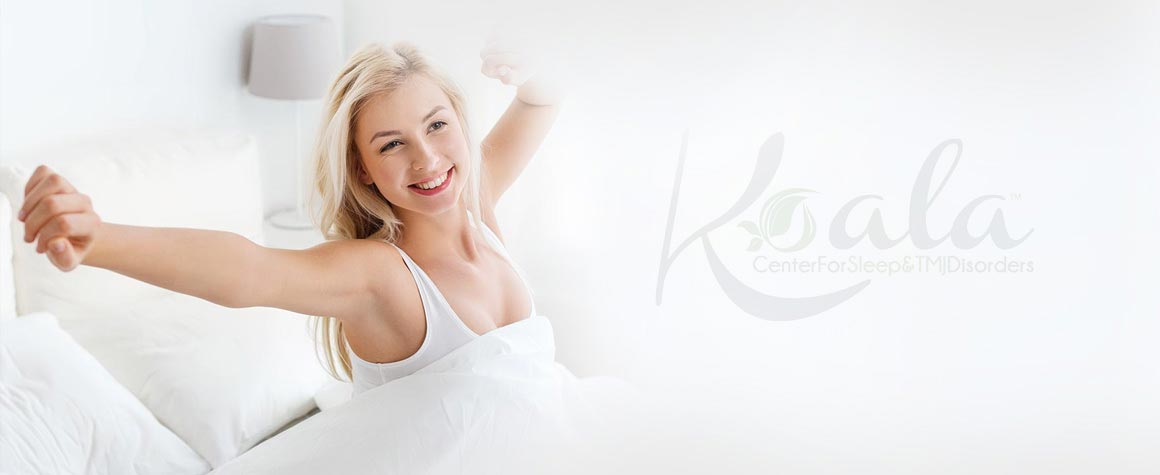Step Back into the Daylight – Koala® Center For Sleep & TMJ Disorders
Do you want to turn your stressful sleep nights into restful sleep nights? Don’t worry, because Koala® Center For Sleep & TMJ Disorders offers the solution for you. Talk to our team of TMJ professionals and receive comprehensive treatment. For more information call us at one of our clinics today or request an appointment online. We serve patients from all over the USA. Locations in Bloomington IL, Peoria – Dunlap IL, El Paso TX, and Wausau WI.


When the morning breaks it brings with it all the hopes and potential of a new day. This is true, at least, for those who awake after a night of restful sleep or for whom the bright light of day does not trigger splitting headaches.
For those who suffer from temporomandibular joint disorder (TMD), each new day may not be so full of potential as much as it is full of discomfort, fatigue, and pain.
There is still hope, however. Should you know the misery of TMD, Koala® Center For Sleep & TMJ Disorders is there to help.
Anatomy of a Disorder
The temporomandibular joint disorder is a condition that can result when the temporomandibular joint (TMJ) slides out of position. The TMJ is located where the ball joint end of the lower jaw, or mandible, meets its corresponding socket in the skull.
“Since the lower jaw isn’t connected to the skeleton except by muscles and tendons, it can be anywhere within the range of the joint,” explains Dr. Rod Willey of Koala® Center For Sleep & TMJ Disorders in Dunlap. “The cheek muscles are designed to position your jaw according to how your teeth fit best. So if your teeth fit together better with your jaw to the right, your muscles will pull to the right every time you chew, swallow, or bring your back teeth together, creating an imbalance in the muscles and an imbalance in the jaw joint.”
The imbalance between the muscles, the teeth, and the jaw joint is what ultimately causes TMD.
Other factors may play a role in one’s likelihood of developing TMD. As one’s skeletal structure is hereditary, if a parent has TMD there may be an increased chance of developing it. Additionally, as a woman’s jaw muscle mass is thinner than a man’s it tends to wear out sooner, making women more susceptible to TMD.
“Stress is also a factor,” Dr. Willey adds. “When you have stress you clench your teeth a lot more, which positions the jaw according to how the teeth fit, and that fatigues the muscles faster. But the biggest factors are teeth that are missing or orthodontics that have created a mismatch between the muscles and jaw joint.”
Signs and Symptoms
Perhaps the most surprising aspect of TMD is how many people have it and don’t know it. Recognizing the indicators of it, therefore, is the first step toward getting it treated.
TMD reveals itself in myriad ways: ringing in the ears; clogged, itchy ears; hearing loss; facial muscle fatigue and cramping; headaches; light sensitivity; popping and clicking of the jaw, limited opening of the mouth; the feeling of something stuck in the throat; neck, shoulder, and back pain; and tingling in the fingertips and extremities. As bad as some of these symptoms are, they can cause a sort of domino effect of even more physical problems.
The discomfort and pain caused by TMD alone can make it difficult to get a good night’s rest. But this can be compounded by the fact that 50 percent of people who have TMD also suffer from sleep apnea. “The two fit hand in hand,” Dr. Willey says. “The body’s best way to fight off apnea—stopped breathing during sleep due to an obstruction—is to clench and grind; it allows you to keep an airway open and breathe at the same time, but it also further exhausts the worn out muscles and exacerbates the compression of the jaw toward the ears and into the joint. The two are related; they are not the same condition, but one can magnify the other.”
Furthermore, the muscular imbalance of TMD can make one particular uncomfortable in daylight. “To go out in the sunlight you have to filter the sunlight by squinting. Squinting is muscle action,” Dr. Willey points out. “If those muscles are sore, it’s going to make you have stronger headaches out in the bright light.”
As it is, the light of a new day is not all that welcome when you’ve spent the night in sleepless misery. Add to it an increased sensitivity to light and it becomes quite clear TMD has the power to completely alter your life.
Creating Balance
One would think a disorder causing headaches, tinnitus, neck pain, and sensitivity to light would have a complicated, expensive, or surgical solution. Dr. Willey is happy to share that is not the case with TMD.
“To treat this we’ve got to find the neutral position of the muscles that will allow them to be in charge instead of the teeth when positioning the lower jaw,” he begins. “So we have to level the bite and we do that with an appliance that goes over the lower teeth for two to three months, allowing the muscles to stay relaxed, to heal, and to get decompression in the jaw joint and around the ears. We’re usually 50 percent better in the first week with the muscular aspect, meaning headaches and neck pain are alleviated.”
Daytime wear is tapered out once the patient is 80 to 90 percent symptom-free. At that point, the appliance is used, indefinitely, as a nightguard.
“During the night the jaw is positioned according to the muscles,” the doctor iterates. “During the waking hours, the jaw is positioned according to the teeth.” The guard is all about creating the balance between teeth, joints, and muscles.
Breaking a Vicious Cycle
It is estimated there are 4.5 million people with TMD in the United States alone. But for such a widespread problem, most cases of TMD actually go undiagnosed. While many physicians are doing their best to help with the pain and discomfort TMD causes, if the disorder itself goes undetected, even the best efforts will be wasted.
“I had a recent patient who was on Valium, sleeping pills, another anti-anxiety med, and strong pain meds,” shares Dr. Willey. “They were on eight different pills, all of them having side effects—all to mask the problem.”
Part of the problem, the doctor says, is not questioning why: Why do I have headaches? Why can I not open my mouth very wide? Why do I keep getting earaches? Unfortunately, many people do not ask those questions, so only the symptoms get treated.
“If you have one leg longer than the other it may cause pain in your back, hips, knees, and more,” Dr. Willey outlines. “A physician can give medication for the pain, but until you get an orthotic for the shoe to level the leg, you won’t be able to correct the improper position of the hip and the pain will return. It’s the same with TMD. We have to level the bite to fix the problem because it’s a mechanical imbalance. The only cure for this is to level the bite so everybody’s happy: the muscles, the joints, and the teeth. The dental appliance for TMD is absolutely the best solution.”
Shout from the Mountaintop
“It makes me sad to have someone come in who has struggled with this for years,” Dr. Willey laments. “It destroys the quality of their life. Chronic pain is hard to deal with. It’s tough to get up in the morning and function through the day when they feel so awful and miserable. They’re spending days in bed because of migraines triggered by tension headaches. They’re missing out on family activities. Because they’ve never had it diagnosed, they’re missing out on years of their lives.”
Reaching out to those who potentially have TMD is, therefore, what drives the doctor. “Treating those patients is what gets me up in the morning,” he shares, “because it’s such a remarkable change and it’s so treatable. I want to educate the community any way I can.”
Thanks to a simple treatment available at Koala® Center For Sleep & TMJ Disorders, there is no need to miss out on any more years or even days of your life because of TMD. It’s time to get a good night’s sleep again, time to live your life and to step back into the daylight.

Additional Services You May Need
▸ KoalaKIDZzz®
▸ Sleep Apnea
▸ Snoring
▸ TMJ Disorder
▸ Fatigue
▸ Sleep Disorders
▸ Weight Loss
▸ CPAP Alternative
▸ Oral Appliances




